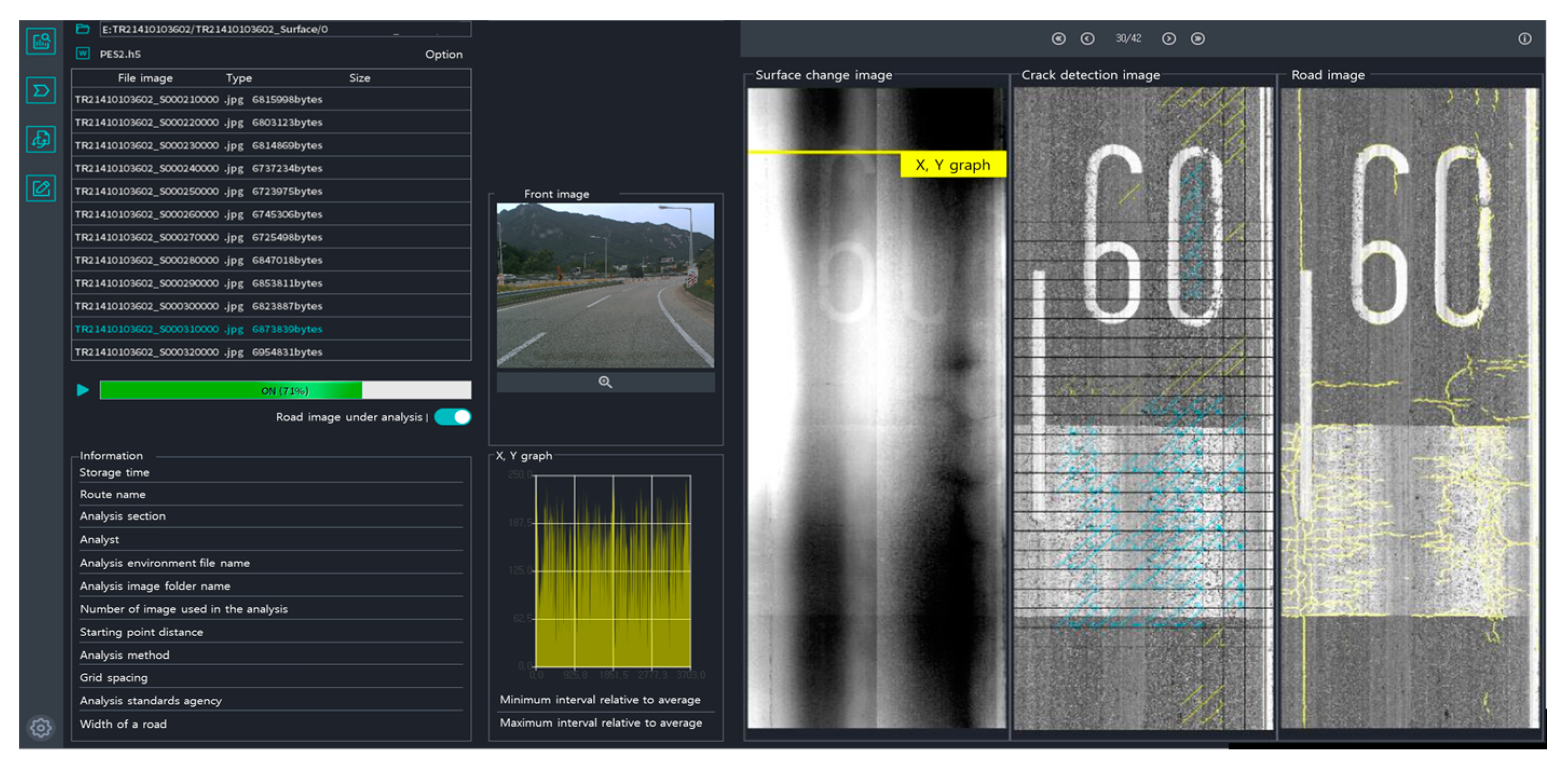Advancement of a Pavement Management System (PMS) for the Efficient Management of National Highways in Korea †
Abstract
:1. Introduction
2. Road Pavement AI Analysis Program
2.1. Program Structure
2.2. Artificial Intelligence Learning Process
2.3. Automation of Road Crack Analysis Program
3. Advanced National Road Pavement Data Management System (PDMS)
3.1. Pdms Database Construction
3.2. PDMS Functional Configuration
4. Pothole Information Management
4.1. Pothole Information Linkage
4.2. Pothole Status Map
5. Conclusions
- Objective crack analysis results were derived by developing a road pavement crack analysis program using AI. Its accuracy is improved using a designing that excluded anomalous objects on the road surface. In the future, this system’s accuracy could be improved by performing additional learning to exclude abnormal items such as manholes and expansion joints. Based on the derived results, an efficient maintenance management system based on consistent standards would be possible.
- The system was enhanced so that the survey data and analysis results of paved general national roads can be checked in units of 100 m per lane using a map. In addition, improvements were made so that survey agencies, analysis agencies, and road management entities can be used to efficiently manage roads through the visualization of survey and analysis results, maintenance sections, and budgets using the advanced general national road pavement data management system. In the future, the usability of this system could be improved by upgrading the construction data upload function and the automatic budget allocation function.
- The pothole information management function is used to monitor pothole occurrence and repair status for general national roads and establish a pothole status map and pothole list. The built pothole information management function makes it possible to take immediate action for potholes in general national roads. Furthermore, it would be possible to efficiently conduct pothole repair by analyzing pothole occurrence frequency per region.
Author Contributions
Funding
Institutional Review Board Statement
Informed Consent Statement
Data Availability Statement
Conflicts of Interest
References
- Lim, J.K.; Lee, S.W.; Kim, Y.J.; Kim, B.G.; Sin, H.J. A Study of Improving Pavement Data Management System of National Highway. In Proceedings of the 2012 Fall Conference of Korea Information Processing Society, Jeju university, Jeju City, Republic of Korea, 22–23 November 2012; p. 1746. [Google Scholar]
- Framework Act on Sustainable Infrastructure Management. Republic of Korea, Act No. 17237. 7 April 2020.
- Lim, J.K. Development of Condition Change Prediction Model for Asphalt Pavement Using National Highway PMS Database. J. Korean Road Soc. 2021, 23, 105–106. [Google Scholar]



Disclaimer/Publisher’s Note: The statements, opinions and data contained in all publications are solely those of the individual author(s) and contributor(s) and not of MDPI and/or the editor(s). MDPI and/or the editor(s) disclaim responsibility for any injury to people or property resulting from any ideas, methods, instructions or products referred to in the content. |
© 2023 by the authors. Licensee MDPI, Basel, Switzerland. This article is an open access article distributed under the terms and conditions of the Creative Commons Attribution (CC BY) license (https://creativecommons.org/licenses/by/4.0/).
Share and Cite
Han, S.; You, H.; Kim, M.; Lee, M.; Lee, N.; Kim, C. Advancement of a Pavement Management System (PMS) for the Efficient Management of National Highways in Korea. Eng. Proc. 2023, 36, 67. https://doi.org/10.3390/engproc2023036067
Han S, You H, Kim M, Lee M, Lee N, Kim C. Advancement of a Pavement Management System (PMS) for the Efficient Management of National Highways in Korea. Engineering Proceedings. 2023; 36(1):67. https://doi.org/10.3390/engproc2023036067
Chicago/Turabian StyleHan, Seungyeon, Hyungmog You, Myeongill Kim, Moonsup Lee, Nuri Lee, and Chulki Kim. 2023. "Advancement of a Pavement Management System (PMS) for the Efficient Management of National Highways in Korea" Engineering Proceedings 36, no. 1: 67. https://doi.org/10.3390/engproc2023036067
APA StyleHan, S., You, H., Kim, M., Lee, M., Lee, N., & Kim, C. (2023). Advancement of a Pavement Management System (PMS) for the Efficient Management of National Highways in Korea. Engineering Proceedings, 36(1), 67. https://doi.org/10.3390/engproc2023036067





